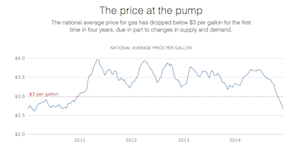Falling energy prices mean tractors are cheaper to run, water is less expensive to pump and crops are more economical to ship.
Arkansas farmers are benefiting from the same forces that have driven down gasoline prices, though falling gasoline prices take the cost of ethanol -- and the money farmers receive to grow corn -- down with them.
"It's certainly a benefit for one side," said Matt King, director of market information and economics for Arkansas Farm Bureau. "But it hinders the other side."
In 2014, the average Arkansas farmer spent about $61,000 on diesel fuel and other energy sources to farm 1,000 acres of land. That's about 16 percent of the average farmer's total operating cost.
Those numbers could fall substantially this year.
Diesel -- which powers irrigation wells, trucks and tractors -- has been slower to decline in price than gasoline. But since December, retail prices have dropped from $3.61 a gallon to $2.93 a gallon, according to the U.S. Energy Information Administration.
Farmers use mostly off-road diesel, which they don't pay state and federal taxes on. King said prices are now around $2 a gallon for that form of fuel.
Rabobank, a global financial services company with a focus on agriculture, said Wednesday that lower oil prices could have a large enough impact to make a noticeable difference in supermarket prices.
"The size of the drop in oil prices combined with the already significantly lower prices of agri-commodities will place substantial downward pressure on global food prices, possibly reaching multi-year lows," said Clara van der Elst, a Rabobank analyst, in a news release.
And in Arkansas, cheaper fuel could have a large impact on rice growers. The average rice farmer spent $127,000 -- $93,000 to run irrigation pumps and another $34,000 on diesel fuel to apply chemicals and fertilizer -- for every 1,000 acres of land.
In fact, rice farmers spend more than 21 percent of their operating costs on energy -- far more than other farmers -- because of the amount of water that needs to be pumped from the ground to grow the crop.
K. Bradley Watkins, research assistant professor of agricultural economics for the University of Arkansas Rice Research and Extension Center, said many rice farmers have adapted to high prices by moving from diesel to electric pumps.
"There's been a sizeable movement," he said. "When fuel costs really skyrocketed, especially for diesel, that's when the transition really started."
Though lower fuel prices will help farmers control the cost of growing their crops, other factors could mean farmers won't see an increase in profit margins.
King said fertilizer costs have yet to fall, though it is made from natural gas, which has declined in price. And the dollar is gaining strength while the economies of Canada and Mexico -- the United States' largest trading partners -- are hurting from low oil prices.
"Our dollar has been fairly weak over the last few years, but we're starting to see it strengthen," King said. "As the dollar gets more expensive, other countries buy less of our product."
Business on 01/30/2015


